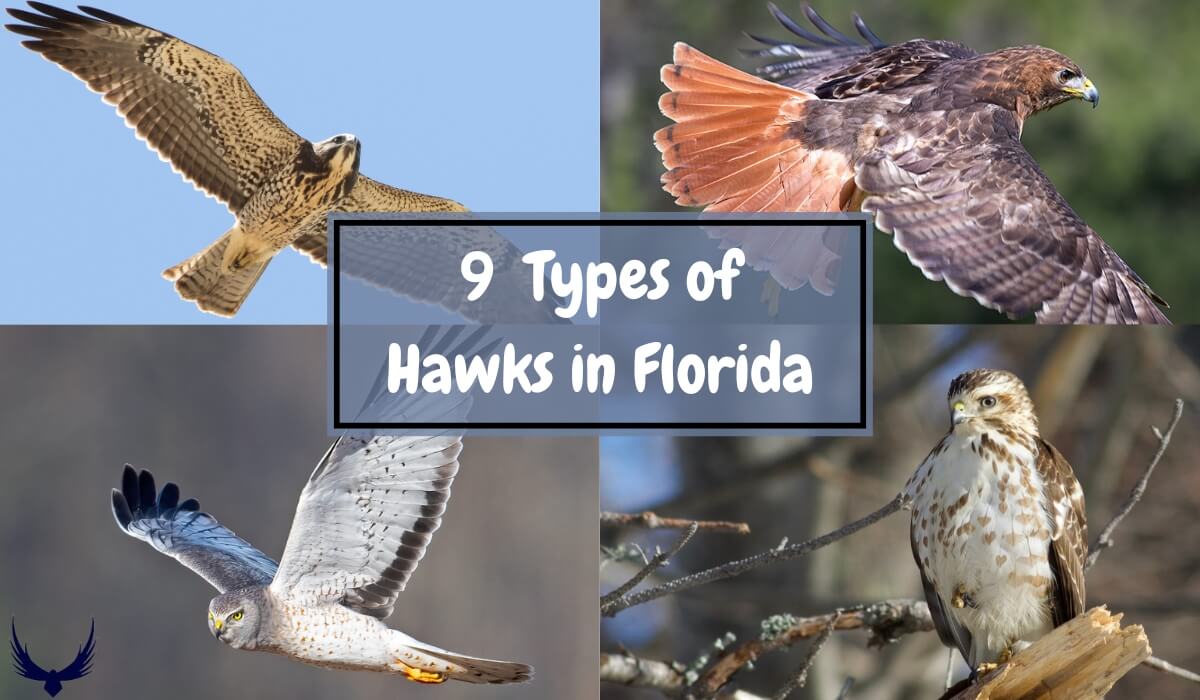Hawks are powerful birds that fly high in the sky. They have sharp eyes and are good at hunting. People who like the nature of hawks are interested in these birds. Florida is a good place for hawks to live, with different kinds of hawks like the Red-tailed Hawk and the Cooper’s Hawk.
Let’s explore where to see Hawks in Florida, how to tell them apart, and learn interesting facts about them. Hawks represent freedom and strength in Florida’s varied landscapes.
9 Types of Hawks in Florida
Florida has many types of hawks. People who like birds can see different kinds in the state. The Red-shouldered Hawk and Red-tailed Hawk are common hawks in Florida. They live in different places in Florida. The Cooper’s Hawk and Sharp-shinned Hawk are also there, with the Sharp-shinned Hawk seen more in winter.
Each hawk species in Florida plays a unique role in the ecosystem by controlling rodent populations and maintaining balance. Observing these birds in nature can help us learn about Florida’s diverse wildlife and the importance of protecting it. Here are the various hawk species found in Florida:
Red-Shouldered Hawk
Characteristics and Identification
- Scientific Name: Buteo lineatus
- Lifespan: 15 to 20 years in the wild
- Length: 16 to 24 inches
- Height: About 1.5 feet when perched
- Weight: 1.1 to 1.9 lbs.
- Wingspan: 37 to 43 inches
Red-Shouldered Hawk is the most common hawk in Florida and Georgia. It is found in wooded and suburban areas. These hawks are medium-sized hawks with reddish-brown shoulders, a barred reddish chest, and a distinctive “kee-aah” call.
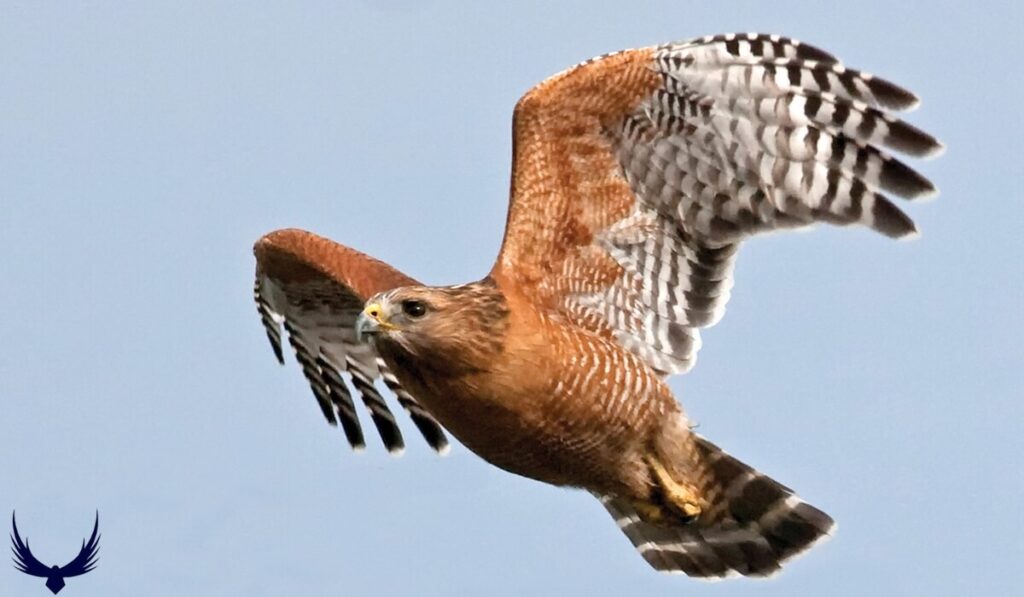
Their wings have black and white checkered pattern, while their tail has narrow white bands alternating with wider black ones.
Habitat
Red-Shouldered Hawks in Florida prefer moist woodlands including bottomland hardwood forests, swamps, and wooded suburbs. They’re found throughout Florida. Their visibility may increase during breeding season but they’re year-round residents in the state.
Feeding Habits
Red Shouldered Hawk in Florida have a varied diet, consuming small mammals, amphibians, reptiles, and small birds. They hunt by perching on branches to scan for prey or flying low through forest canopies.
Breeding and Conservation
The breeding season in Florida runs from late winter to early summer, with peak activity from March to May. They construct nests in tree branches and lay 2 to 4 eggs. Both parents participate in incubation and care of the young.
Conservation efforts have helped these hawks adapt to suburban environments, but they still face challenges from habitat loss and pollution. Protecting their habitats remains crucial for their long-term survival in Florida.
Northern Harrier
Characteristics and Identification
- Scientific Name: Circus hudsonius
- Life span: 4 to 8 years in the wild, Maximum recorded is 16 years
- Length: 16 to 20 inches
- Height: About 18 inches when perched
- Weight
- Males: 12 to 18 oz
- Females: 15 to 28 oz
- Wingspan: 40 to 46 inches
The Northern Harrier known as Marsh Hawk, is a medium-sized raptor with an owl-like face and distinctive low-flying hunting style. In Florida, they are winter residents.

Adult males are gray above and white below, while females are brown above and streaked below. Both sexes have a white rump patch visible in flight. Their flight is characterized by slow, low glides with V-shaped wings.
Habitat
Northern Harriers of Florida prefer open habitats such as marshes, grasslands, and agricultural fields. In Florida, they inhabit coastal marshes, wet meadows, and large open areas throughout the state. Their population in Florida increases during migration and winter months.
Feeding Habits
These raptors primarily feed on small mammals, birds, reptiles, and amphibians in Florida. They hunt by flying low over open areas, using both sight and hearing to locate prey.
Breeding and Conservation
Northern Harriers do not breed in Florida. They are winter visitors to the state, arriving in the fall and departing in the spring. Their breeding grounds are in the northern United States and Canada.
Conservation efforts focused on preserving open habitats are crucial for maintaining their winter populations. Birdwatchers in Florida can best observe Northern Harriers from late September through early April, with peak numbers in mid-winter.
Red-Tailed Hawk
Characteristics and Identification
- Scientific Name: Buteo jamaicensis
- Lifespan: 10 to 15 years in the wild, can reach up to 25 to 30 years in captivity
- Length: 18 to 26 inches
- Height: About 12 to 16 inches when perched
- Weight: 2 to 3.5 lbs.
- Wingspan: 44 to 53 inches
Red-Tailed Hawks are large, robust members of the Buteo genus, common in both Florida and Michigan year-round. Red-Tailed Hawk is the largest hawk in Florida and adaptable to various habitats from forests to urban areas.

Adults are recognizable by their brick-red tail, dark brown back, pale underparts, and dark belly band.
Habitat
Red-tailed Hawks in Florida inhabit diverse environments including forests, open countryside, parks, and cities. They’re often seen perched high or soaring over open areas.
Feeding Habits
Red tailed Hawk in Florida hunt small to medium-sized mammals, birds, and reptiles. They hunt from high perches or while flying, diving to catch prey. They play a crucial role in controlling small mammal populations.
Breeding and Conservation
Breeding occurs in late winter to early spring. Females lay 2 to 3 eggs, which both parents incubate for about a month. These biggest hawk in Florida face threats from habitat loss, collisions, and illegal shooting.
Birdwatching
Birdwatchers can spot these large hawks in Florida, in both rural and urban settings. They’re often seen soaring on thermals and are known for their distinctive raspy “kree-eee-ar” call.
Cooper’s Hawk
Characteristics and Identification
- Scientific Name: Accipiter cooperii
- Lifespan: 8 to 12 years in the wild
- Length: 14 to 20 inches
- Weight
- Males: 8 to 14 oz
- Females: 13 to 24 oz
- Wingspan: 28 to 38 inches
Cooper’s Hawks are medium-sized raptors found in Florida’s woodlands and suburban areas. They have blue-gray backs, rusty barred chests, and dark caps.
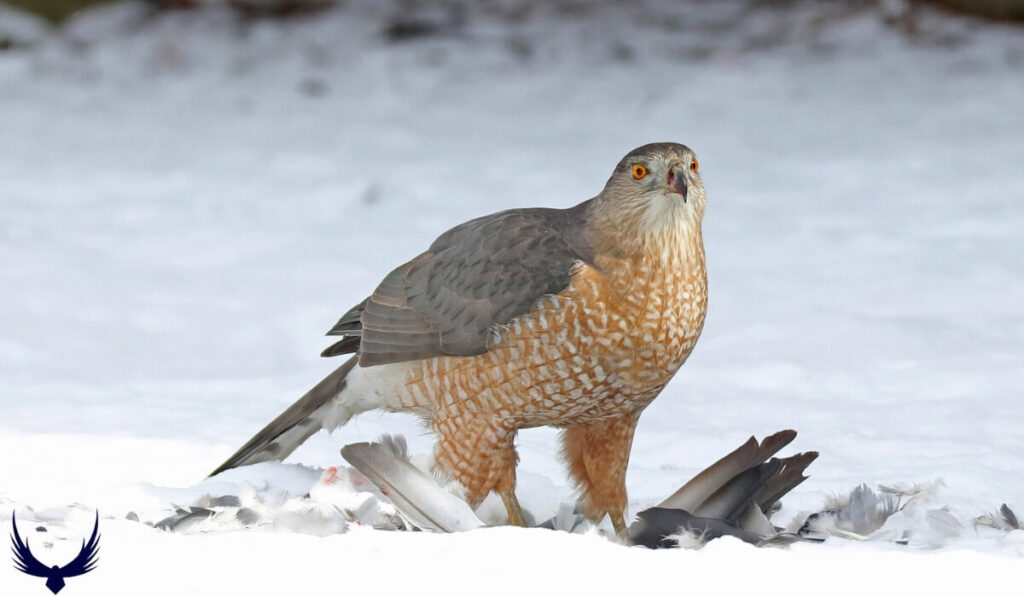
Their long tails with rounded ends and short, rounded wings distinguish them from the similar Sharp-shinned Hawk. Females are larger than males, and juveniles have brown backs with streaked underparts.
Habitat
Cooper’s Hawks are year-round residents in Florida, inhabiting diverse environments from dense forests to suburban areas. They are skilled at navigating through woodlands and are often seen near backyard bird feeders.
Feeding Habits
Cooper’s Hawk in Florida preys on medium-sized birds like doves, starlings, robins, and small mammals. They hunt using short bursts of high-speed flight through wooded areas, relying on their agility to surprise prey.
Breeding and Conservation
Breeding occurs from March to June in deciduous or mixed forests. Females lay 3 to 5 eggs, which hatch after about a month. Both parents rear the young.
After facing declines in the mid-20th century due to pesticide use and habitat loss, Cooper’s Hawk populations have recovered and are now stable in Florida.
Birdwatching
Birdwatchers can spot Cooper’s Hawks year-round in Florida. They can be seen perching on tree branches, flying through wooded areas, or hunting near bird feeders.
Sharp-Shinned Hawk
Characteristics and Identification
- Scientific Name: Accipiter striatus
- Lifespan: Average 3 to 5 years in the wild, can reach up to 12 years
- Length: 9 to 14 inches and males are smaller than females
- Weight
- Males: 3 to 4 oz
- Females: 5 to 8 oz
- Wingspan: 20 to 26 inches
Sharp-Shinned Hawks are small raptors found in Florida year-round, with increased numbers during fall and winter migration. They have blue-gray upperparts, rusty barred underparts, and a dark cap.

Key features include their small size, square-tipped tail, and less pronounced head projection in flight compared to the similar Cooper’s Hawk. Females are larger than males.
Habitat
Sharp-Shinned Hawks of Florida inhabit various wooded areas including deciduous, coniferous, and mixed forests. This small hawk in Florida is adaptable and can be found in suburban environments with sufficient tree cover. During migration, they may be observed in more open areas.
Feeding Habits
These small hawks in Florida hunt small songbirds. Their diet includes species like chickadees, titmice, and sparrows. Sharp-Shinned Hawk’s small size and agility make them efficient predators of these birds.
Breeding and Conservation
Some Sharp-Shinned Hawks breed in Florida in the northern parts of the state, many migrate north to breed. They nest in dense forests, with females laying 4 to 5 eggs in a hidden nest high in a tree. Both parents participate in incubation and chick-rearing.
Their populations have recovered from mid-20th century declines due to DDT use, but they still face conservation challenges.
Birdwatching
Sharp-shinned Hawks can be observed in Florida year-round, with the best viewing opportunities during fall migration (September to November). Birdwatchers often spot them flying through forests or hunting near bird feeders.
Broad-Winged Hawk
Characteristics and Identification
- Scientific Name: Buteo platypterus
- Lifespan: average 12 years, can reach up to 18 years in the wild
- Length: 13 to 17 inches
- Weight: 9 to 20 oz
- Wingspan: 31 to 39 inches
Broad-Winged Hawks are medium-sized raptors present in Florida from spring to fall, with some overwintering in the south. They have short, broad wings and a banded tail.
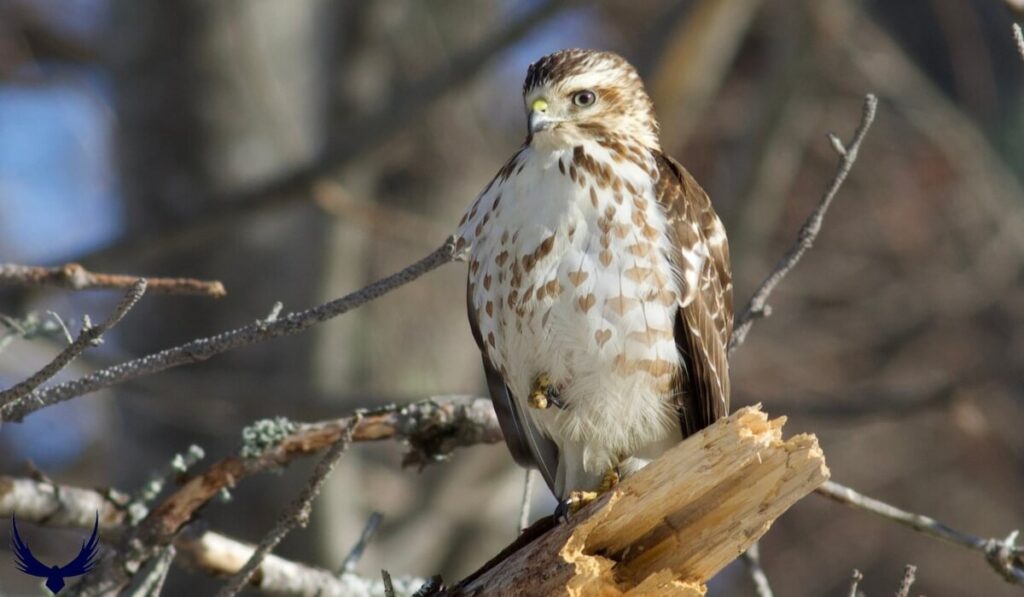
Adults have dark brown backs with barred chests and bellies, while juveniles are more streaked. In flight, they display a distinctive white tail band bordered by darker bands.
Habitat
Broad-Winged Hawks prefer deciduous or mixed forests in Florida in the northern and central regions. They’ve adapted to fragmented forests and may be seen in suburban areas with sufficient tree cover.
Feeding Habits
Broad-Winged Hawks in Florida eat small mammals, amphibians, and insects. They hunt by perching quietly and making short flights to capture ground prey.
Breeding and Migration
Breeding pairs perform courtship displays including spiraling flights. They nest in forests, with females laying 2 to 3 eggs. In September and early October, these hawks form large migratory groups called “kettles,” often numbering in the thousands, as they begin their journey to South America.
This migration can be observed in Florida, in the northern part of the state.
Conservation
Conservation efforts focus on protecting large, forested areas crucial for breeding. Broad-winged Hawks of Florida face challenges from habitat loss due to urbanization and agriculture. Climate change may impact their future migration and breeding patterns.
Birdwatching
Florida birdwatchers can observe Broad-Winged Hawks during their spring arrival in April and May, throughout the summer breeding season and during their fall migration in September.
Rough-Legged Hawk
Characteristics and Identification
- Scientific Name: Buteo lagopus
- Lifespan: Average 8 years, can reach up to 18 years in the wild
- Length: 18 to 24 inches
- Weight: 1.6 to 3.0 lbs.
- Wingspan: 50to 54 inches
Rough-legged Hawks are uncommon winter visitors to Florida, present from late October through early April. They have variable plumage, with light morphs being more common.
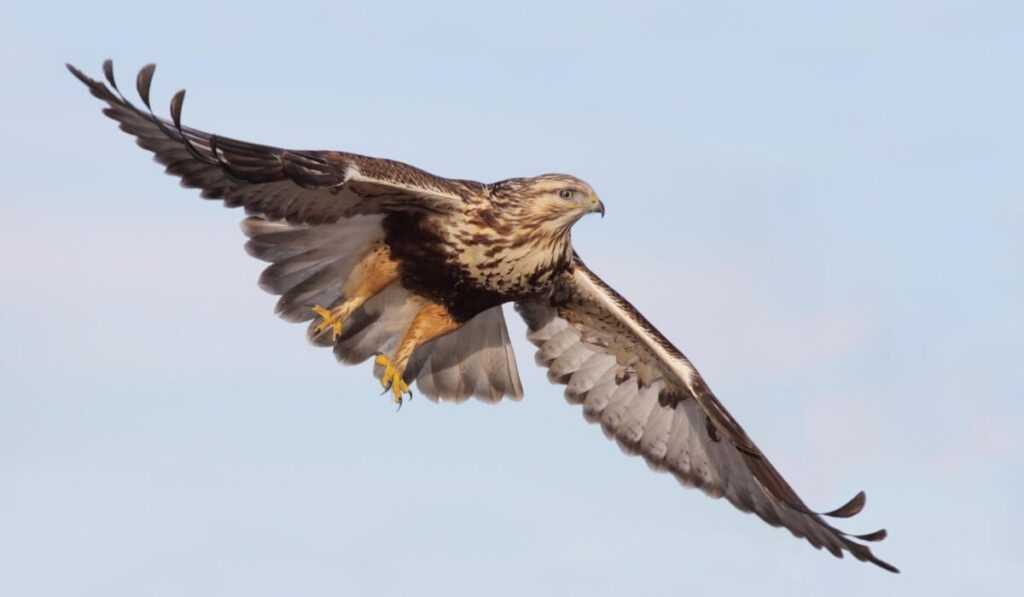
Key identifying features include feathered legs, a pale head and chest contrasting with a dark belly band, and dark carpal patches on the underwings. Their appearance can be like other buteo species, making identification challenging.
Habitat
Rough-Legged Hawks in Florida prefer open habitats such as fields, grasslands, and coastal marshes. They are found in the northern and central parts of the state with localized distributions based on suitable habitat and prey availability.
Feeding Habits
Rough-Legged Hawks prey on small mammals like voles and mice. They hunt by flying low over open areas or hovering.
Breeding and Conservation
Rough-Legged Hawks, as winter visitors, do not breed in Florida and return to the Arctic in spring for breeding.
Conservation efforts focus on preserving winter habitats including open grasslands and agricultural areas. Not currently endangered, Rough-legged Hawks face challenges from habitat loss due to urban development and changes in agricultural practices.
Birdwatching
Birdwatchers can observe Rough-Legged Hawks in Florida from November to March. The best locations are open fields in the northern and central regions of the state including wildlife areas, refuges, and farmlands.
Short-Tailed Hawk
Characteristics and Identification
- Scientific Name: Buteo brachyurus
- Lifespan: around 10 to 15 years in the wild, with some reaching 20 years or more in captivity.
- Length: 15.3 to 17.3 inches
- Weight: 0.8 to 1.1 lbs.
- Wingspan: 32 to 41 inches
The Short-Tailed Hawk is one of the smallest buteos in North America. They have two color morphs, dark and light, with the dark morph being more common in Florida. The dark morph is uniformly dark brown, while the light morph has a white underside with dark flight feathers.
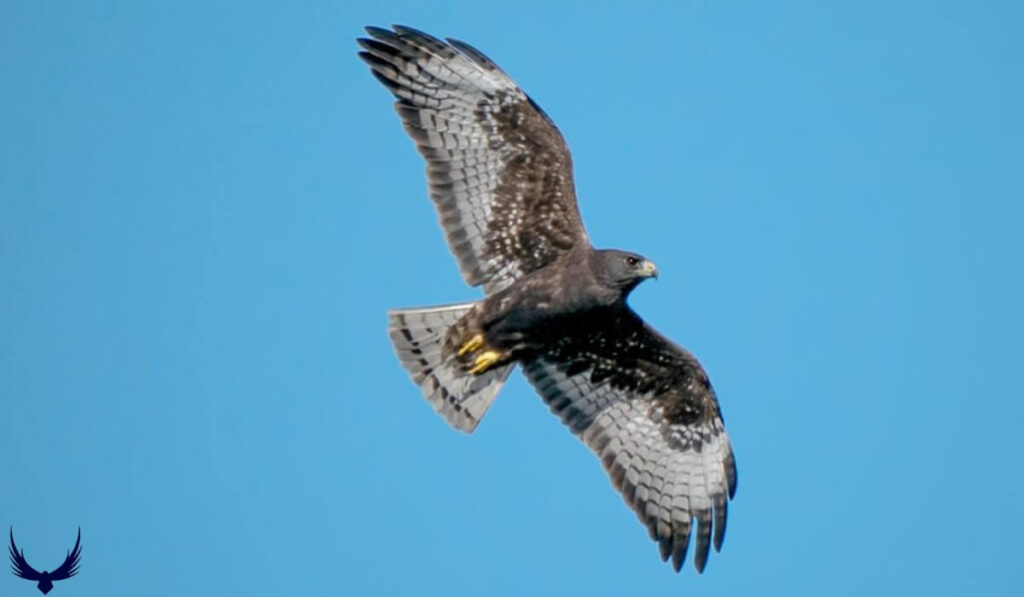
Both morphs have a distinctive short, broad tail. Short-Tailed Hawks are often confused with Broad-Winged Hawks but can be distinguished by their shorter tail and different flight pattern.
Habitat
Short-Tailed Hawks in Florida prefer forested areas near wetlands and cypress swamps. They are found year-round in the southern part of Florida including the Everglades, and seasonally in central Florida. These hawks’ nest in tall trees, often choosing the tallest available in their territory.
Feeding Habits
Short-Tailed Hawks are unique among North American raptors in that they primarily feed on small birds caught in flight. They hunt by soaring high above the forest canopy, then diving steeply to capture prey. They also prey on small mammals, reptiles, or insects.
Breeding and Conservation
Short-Tailed Hawks of Florida breed from late March through June. They build their nests high in tall trees, often in pine forests or mixed woodlands. The female lays 1 to3 eggs, and both parents participate in incubating the eggs and caring for the young.
Short-Tailed Hawks face localized challenges in Florida due to habitat loss and degradation. Conservation efforts focus on preserving their forested habitats in South Florida.
Birdwatching
The best time to observe Short-Tailed Hawks in Florida is during their breeding season from late winter to early summer. Good locations include Everglades National Park, Big Cypress National Preserve, and various wildlife management areas in South and Central Florida.
Swainson’s Hawk
Characteristics and Identification
- Scientific Name: Buteo swainsoni
- Lifespan: 15 to 20 years in the wild
- Length: 18.5 to 22 inches
- Weight: 1.5 to 3 lbs.
- Wingspan: 47 to 54 inches
Swainson’s Hawks are not common in Florida. They are found in western North America and migrate to South America for the winter. They have a distinctive flight silhouette with long, pointed wings. Adults have dark flight feathers contrasting with lighter bodies, while juveniles are more uniformly brown.

Swainson’s Hawks might be confused with local Buteo species in Florida, so careful observation of flight pattern and coloration is key for identification.
Habitat
Swainson’s Hawks in Florida are most likely to be spotted in open areas such as grasslands, agricultural fields, and prairies during their migration. They don’t have established habitats in the state as they are not regular residents or breeders in Florida.
Feeding Habits and Breeding
Swainson’s Hawks diet includes small mammals, reptiles, and large insects. Swainson’s Hawks don’t breed in Florida. They are rarely seen in the state, only during spring and fall migrations. Their breeding grounds are in western North America, ranging from Alaska to northern Mexico.
Conservation
Swainson’s Hawks have conservation challenges in their main areas, their rare occurrence in Florida means local conservation efforts are not specifically focused on this species. But general habitat preservation for migratory birds can benefit Swainson’s Hawks during their passages through Florida.
Birdwatching
Spotting a Swainson’s Hawk would be a rare treat for birdwatchers in Florida. The best chances for observation are during spring and fall migration periods, in open areas in the Florida Panhandle or along coastal migration routes.
Where to Find Hawks in Florida?
The best times for hawk-watching are often during migration seasons (spring and fall) and in the early morning or late afternoon when many hawks are most active.
Following are the main location to spot different types of hawks in Florida:
- Everglades National Park: Home to various hawk species including Red-shouldered Hawks and Short-tailed Hawks.
- Merritt Island National Wildlife Refuge: Good for spotting Red-tailed Hawks and Ospreys.
- Paynes Prairie Preserve State Park: Offers opportunities to see Red-shouldered and Red-tailed Hawks.
- St. Marks National Wildlife Refuge: Great for observing migrating hawks during fall and spring.
- Corkscrew Swamp Sanctuary: Home to Red-shouldered Hawks
- Tall Timbers Research Station: Good for observing various hawk species in north Florida.
Important Precautions
- Avoid feeding the hawks
- Do not disturb or touch hawk nests during breeding season.
- Follow the rules of the park or wildlife refuge you are visiting.
FAQs – Types of Hawks in Florida
What Kind of Hawks are in Florida?
Florida has many types of hawks, some live there all year and others visit at certain times. The most common hawks in Florida are Red-shouldered Hawks, Red-tailed Hawks, Cooper’s Hawks, and Sharp-shinned Hawks. Other hawks in Florida include Short-tailed Hawks in the south, Broad-winged Hawks during migration, and Northern Harriers in winter. Each type of hawk in Florida lives in different places, like forests, grasslands, and wetlands.
What Do Hawks Eat in Florida?
Hawks in Florida eat different things depending on the type of hawk. They usually eat small animals like mice, rats, squirrels, rabbits, snakes, lizards, frogs, and birds. Some hawks, such as Ospreys, mainly eat fish. Others eat dead animals when they find them. The specific diet of each hawk species is adapted to its habitat and hunting capabilities.
When Do Hawks Mate in Florida?
Hawks in Florida mate during the late winter to early spring, with most species start to breed between January and March. The exact timing can vary slightly depending on the species and local climate conditions. For example, Red-shouldered Hawks nest in January or February, while Red-tailed Hawks start nesting in February or March.
Is it Illegal to Kill a Hawk in Florida?
Yes, it is illegal to kill hawks in Florida. Hawks are protected under both federal and state laws including the Migratory Bird Treaty Act and Florida’s wildlife protection statutes. Killing, capturing, or harming hawks without proper permits is a serious offense that can result in fines and imprisonment. These laws are in place to protect hawks and other raptors, recognizing their important role in the ecosystem.
What is the Most Common Hawk in Florida?
The Red-shouldered Hawk is the most common hawk in Florida. This medium-sized hawk is found in various habitats including forests, swamps, and suburban areas all year.
Can You Own a Hawk in Florida?
In Florida, owning a hawk is allowed but needs special permits. You must get a federal falconry permit from the U.S. Fish and Wildlife Service and a state falconry permit from the Florida Fish and Wildlife Conservation Commission. These permits require further training, passing a test, and meeting strict care rules. Hawk ownership is serious and usually for licensed falconers who hunt with the birds.

